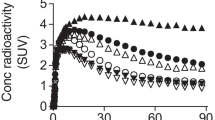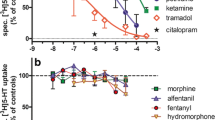Abstract
Association of3H-histamine (3H-H) with HL-60 cells was a time- and temperature-dependent process. At 37°C, the association of3H-H (50 fmole/106 cells) was maximal and constant 60 min after the addition of HL-60 cells, while there is no significant radioactivity associated with cells incubated at 4°C during 120 min incubation. Under these conditions, the cell-associated radioactivity remains unchanged, even after a washout period and addition of large excess (10−3 M) of histamine, indicating an irreversible interaction between histamine and HL-60 cells. The interaction of3H-H with HL-60 cells depends on cell viability, cell concentration and was reduced by various metabolic inhibitors such as iodacetamide, dinitrophenol, sodium azide and ouabain. Histamine uptake by HL-60 cells was inhibited by a series of H1, H2 histamine agonists (impromidine, histamine, 4-MH, AET, PEA) and antagonists (cimetidine, oxmetidine, ranitidine, diphenhydramine), according to the following order of potencies: 1>H, 4-MH>AET>PEA and H, C>DPH. Among the histamine analogs tested (acidN-acetyl histamine, imidazole, acid imidazole acetic and histidine), only theN-acetyl histamine acid was able to inhibit3H-H uptake by HL-60 cells. Three antidepressant drugs (amitriptyline, imipramine, clomipramine) also antagonize3H-H uptake by HL-60 cells, but this effect was only observed at toxic concentrations (10−5 M and above) and was related to a loss of the cell viability. It was concluded that the promyelocytic leukemia cells HL-60 take up histamine by a specific energy-dependent mechanism, preferentially inhibitable by histamine H2-receptor agonists and antagonists (H2>H1). Therefore, the uptake of3H-H by HL-60 cells accounts for an H2-receptor-mediated process, consistent with the pharmacological specificity of the histamine H2-receptor linked to the cAMP generating system in this cell line.
Similar content being viewed by others
References
W.W. Busse andJ. Sosman,Histamine inhibition of neutrophil lysosomal enzyme release: an H 2 histamine receptor response, Science (Wash D.C.)194, 737–738 (1976).
C. Gespach andJ.-P. Abita,Human polymorphonuclear neutrophils. Pharmacological characterization of histamine receptors mediating the elevation of cyclic AMP, Mol. Pharmacol.21, 78–85 (1982).
C. Gespach, F. Saal, H. Cost andJ.-P. Abita,Identification and characterization of surface receptors for histamine in the human promyelocytic leukemia cell line HL-60, Mol. Pharamcol.22, 547–553 (1982).
J.-P. Abita, C. Gespach, H. Cost, O. Poirier andF. Saal,Changes in cyclic AMP levels during differentiation of HL-60 cells, I.R.C.S. Medical Science10, 882–883 (1982).
S.J. Collins, R.C. Gallo andR.E. Gallagher,Continuous growth and differentiation of human myeloid leukemia cells in suspension culture, Nature, Lond.270, 347–349 (1977).
S.J. Collins, F.W. Ruscetti, R.E. Gallagher andR.C. Gallo,Terminal differentiation of human promyelocytic leukemia cells induced by dimethyl sulfoxide and other polar compounds Proc. Natn. Acad. Sci. USA75, 2458–2462 (1978).
J.P. Green andS. Maayani,Tricyclic antidepressant drugs block histamine H 2 receptor in brain, Nature, Lond.269, 163–165 (1977).
E. Richardson,Tricyclic antidepressants block histamine H 2 receptors of mouse neuroblastoma cells, Nature, Lond.274, 176–177 (1978).
J. Figge, P. Leonard andE. Richelson,Tricyclic antidepressants: potent blockade of histamine H 1 receptors of guinea pig ileum, Eur. J. Pharmac.58, 479–483 (1979).
C. Gespach, S. Emami, N. Boige andC. Rosselin,Chemical differentiation of histamine receptors coupled to cyclic AMP generation in human and guinea pig fundic glands. InGut Peptides and Ulcer, pp. 55–63. (Ed.A. Miyoshi). Tokyo Biomedical Research Foundation 1983.
S. Emami, C. Gespach, M.-E. Forgue-Lafitte, Y. Broer andG. Rosselin,Histamine and VIP interactions with receptor-cyclic AMP systems in the human gastric cancer cell line HGT-1, Life Sci.33, 415–423 (1983).
R. Levi, R. Ganellin, G. Allan andH.J. Willens,Selective impairment of atrioventricular conduction by 2-(2-pyridyl)-ethylamine and 2-(2-thiazole)-ethylamine, two histamine H 1-receptor agonists, Eur. J. Pharmac.34, 237–240 (1975).
Author information
Authors and Affiliations
Rights and permissions
About this article
Cite this article
Gespach, C., Marrec, N. & Balitrand, N. Relationship between3H-histamine uptake and H2-receptors in the human promyelocytic leukemia cell line HL-60. Agents and Actions 16, 279–283 (1985). https://doi.org/10.1007/BF01983160
Issue Date:
DOI: https://doi.org/10.1007/BF01983160




